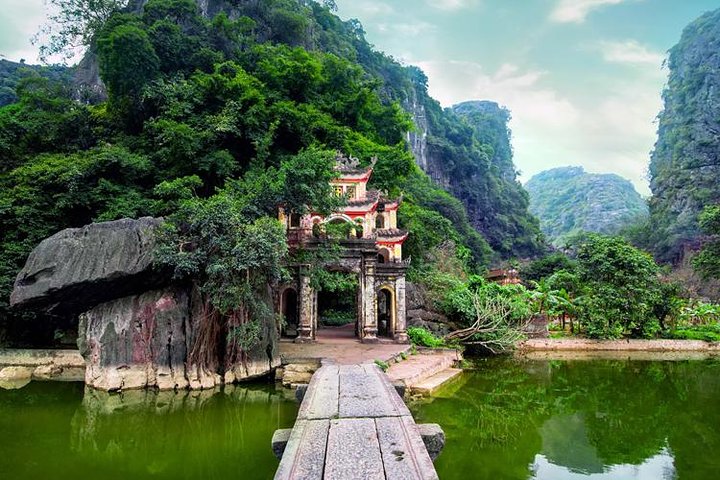
Gia Viễn District, nestled in the heart of Ninh Bình, Vietnam, is a hidden gem that offers a perfect blend of natural beauty, cultural heritage, and unique experiences. This picturesque district is surrounded by stunning limestone karst landscapes, lush greenery, and serene waterways, making it an ideal destination for nature lovers and adventure seekers alike.
One of the must-visit attractions in Gia Viễn is the Bai Dinh Pagoda, Southeast Asia’s largest pagoda. Visitors can embark on a Pagoda Day Trip to explore this magnificent site, which boasts impressive architecture and a tranquil atmosphere. The pagoda complex is also home to a giant bronze Buddha statue, adding to its spiritual allure.
For those who enjoy exploring natural wonders, the Trang An Grottoes are a must-see. A Grottoes Tour offers a chance to navigate through a network of caves and waterways, surrounded by breathtaking limestone peaks. This UNESCO World Heritage site is a testament to the region’s geological and cultural significance.
Adventure enthusiasts will find the Mua Cave Scenic Viewpoint to be a highlight of their trip. A Scenic Viewpoint Tour provides an opportunity to climb to the top of the Mua Cave for a panoramic view of the surrounding landscape. The sight of the winding rivers and lush rice fields from above is truly unforgettable.
For a more immersive cultural experience, visitors can participate in a Herbal Bath & Soap Making session. This unique activity allows travelers to learn about traditional Vietnamese herbal remedies and create their own herbal soap, providing a hands-on experience that is both educational and relaxing.
Gia Viễn District is also an excellent base for exploring the wider Ninh Bình region. A Day Trip from Hanoi offers a convenient way to visit other notable sites such as the ancient Hoa Lu Citadel and the breathtaking Tam Coc. This tour provides a comprehensive overview of the region’s rich history and stunning landscapes.
Whether you’re a history buff, nature enthusiast, or simply looking for a peaceful retreat, Gia Viễn District has something to offer everyone. Its unique blend of cultural heritage, natural beauty, and engaging activities make it a destination worth exploring.
Gia Viễn District, nestled in the heart of Ninh Bình, Vietnam, is a hidden gem that offers a perfect blend of natural beauty, cultural heritage, and unique experiences. This picturesque district is surrounded by stunning limestone karst landscapes, lush greenery, and serene waterways, making it an ideal destination for nature lovers and adventure seekers alike.
One of the must-visit attractions in Gia Viễn is the Bai Dinh Pagoda, Southeast Asia’s largest pagoda. Visitors can embark on a Pagoda Day Trip to explore this magnificent site, which boasts impressive architecture and a tranquil atmosphere. The pagoda complex is also home to a giant bronze Buddha statue, adding to its spiritual allure.
For those who enjoy exploring natural wonders, the Trang An Grottoes are a must-see. A Grottoes Tour offers a chance to navigate through a network of caves and waterways, surrounded by breathtaking limestone peaks. This UNESCO World Heritage site is a testament to the region’s geological and cultural significance.
Adventure enthusiasts will find the Mua Cave Scenic Viewpoint to be a highlight of their trip. A Scenic Viewpoint Tour provides an opportunity to climb to the top of the Mua Cave for a panoramic view of the surrounding landscape. The sight of the winding rivers and lush rice fields from above is truly unforgettable.
For a more immersive cultural experience, visitors can participate in a Herbal Bath & Soap Making session. This unique activity allows travelers to learn about traditional Vietnamese herbal remedies and create their own herbal soap, providing a hands-on experience that is both educational and relaxing.
Gia Viễn District is also an excellent base for exploring the wider Ninh Bình region. A Day Trip from Hanoi offers a convenient way to visit other notable sites such as the ancient Hoa Lu Citadel and the breathtaking Tam Coc. This tour provides a comprehensive overview of the region’s rich history and stunning landscapes.
Whether you’re a history buff, nature enthusiast, or simply looking for a peaceful retreat, Gia Viễn District has something to offer everyone. Its unique blend of cultural heritage, natural beauty, and engaging activities make it a destination worth exploring.




















